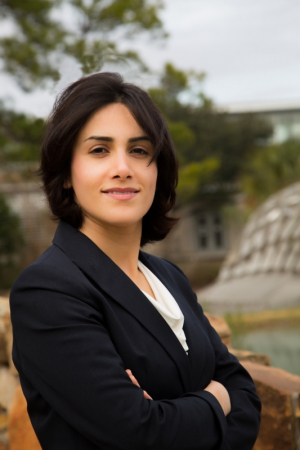If you lie down on the couch and put your hand over your heart, you’ll feel your chest rise and fall with each breath. It seems trivial, but the movement of lungs expanding and contracting can drastically change radiation treatment options for patients with lung cancer.
As these patients breathe, the tumor in their lung moves along with the surrounding tissue, sometimes causing radiation to miss the tumor entirely and instead blast healthy cells with its toxic rays. For many physicians, this problem can determine whether or not a patient even receives radiation therapy – but not if Laleh Kardar has anything to do with it.
Kardar is a Ph.D. student studying industrial engineering at the UH Cullen College of Engineering. Her advisor – industrial engineering department chair Gino Lim – suggested she help him with his research on optimizing proton therapy, an advanced form of radiation treatment. Since Kardar already had a master’s degree in biomedical engineering, she said it made perfect sense for her to dive right into cutting-edge cancer treatment research alongside Lim.
Initially, Kardar studied beam angle optimization, which is the process of identifying the most effective angle to use when delivering radiation to a tumor. “It’s a very large optimization problem,” Kardar said. For instance, there may be 36 possible angles to deliver radiation from and physicians will be asked to choose the six that combine to provide the best treatment. That leaves them with 72 million combinations to choose from. That’s simply too complex of a problem for even the most skilled, most experienced patient care teams. Often, they use simple trial and error, which runs the risk of damaging healthy tissues and forces doctors to balance the delivery of a high, effective dose of radiation with the risk of damaging or killing non-cancerous cells surrounding the tumor. Other times, they rely on algorithms to tell them which angles to use, but these algorithms are complex and very time consuming, even for a high-powered computer to solve.
So Kardar and Lim used industrial engineering techniques to “come up with some solution approaches that find the angle set in a reasonable amount of time,” Kardar said. “Using our tool, we’ve developed a new model which can actually solve the problem very efficiently.”
A big part of this research involves factoring in the patient’s involuntary movements, which can shift the tumor location and result in an incomplete dose of radiation. For example, motions made during inhaling and exhaling by the patient can cause the location of a lung tumor to move during a treatment session. This presents a large problem to physicians because the radiation beam does not move with the breathing motions, so as the patient breathes and the tumor moves, the risk of healthy cells being damaged by the radiation increases.
“So at MD Anderson, we analyzed the amount of motion of more than 100 lung cancer patients, and we developed a tool which can help the physician predict the outcome of the treatment,” Kardar said. “Based on the outcome, they can decide if they can treat the patient using the radiation therapy.”
Specifically, because the lungs are so close to such vital organs such as the heart, spinal cord and esophagus, Kardar said some physicians will avoid treating patients with small lung tumors because they run the risk of missing the tumor completely as the patient breathes.
Most recently, Kardar has been working to study the rate of tumor shrinkage during a period of radiation treatment. Because shrinkage isn’t always taken into account, sometimes by the end of the treatment, the amount of radiation is too large because the tumor is smaller than when the treatment began. By analyzing the rate of shrinkage, Kardar hopes to provide more insight into exacting radiation doses throughout the treatment.
For Kardar, using her industrial engineering background in the field of cancer research is extremely fulfilling. “I find this kind of stuff more practical. I think many researchers… are not using the outcome of their research. They just research something and maybe they can publish it, but after they graduate, they start doing something completely different. But I think what I’m working on is very practical, and since I’m working with MD Anderson and I’m seeing how they’re using these tools we develop and taking advantage of all the studies we are doing, it makes me feel much better.”
